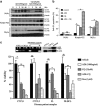Promoter methylation of argininosuccinate synthetase-1 sensitises lymphomas to arginine deiminase treatment, autophagy and caspase-dependent apoptosis
- PMID: 22764101
- PMCID: PMC3406582
- DOI: 10.1038/cddis.2012.83
Promoter methylation of argininosuccinate synthetase-1 sensitises lymphomas to arginine deiminase treatment, autophagy and caspase-dependent apoptosis
Abstract
Tumours lacking argininosuccinate synthetase-1 (ASS1) are auxotrophic for arginine and sensitive to amino-acid deprivation. Here, we investigated the role of ASS1 as a biomarker of response to the arginine-lowering agent, pegylated arginine deiminase (ADI-PEG20), in lymphoid malignancies. Although ASS1 protein was largely undetectable in normal and malignant lymphoid tissues, frequent hypermethylation of the ASS1 promoter was observed specifically in the latter. A good correlation was observed between ASS1 methylation, low ASS1 mRNA, absence of ASS1 protein expression and sensitivity to ADI-PEG20 in malignant lymphoid cell lines. We confirmed that the demethylating agent 5-Aza-dC reactivated ASS1 expression and rescued lymphoma cell lines from ADI-PEG20 cytotoxicity. ASS1-methylated cell lines exhibited autophagy and caspase-dependent apoptosis following treatment with ADI-PEG20. In addition, the autophagy inhibitor chloroquine triggered an accumulation of light chain 3-II protein and potentiated the apoptotic effect of ADI-PEG20 in malignant lymphoid cells and patient-derived tumour cells. Finally, a patient with an ASS1-methylated cutaneous T-cell lymphoma responded to compassionate-use ADI-PEG20. In summary, ASS1 promoter methylation contributes to arginine auxotrophy and represents a novel biomarker for evaluating the efficacy of arginine deprivation in patients with lymphoma.
Figures






Similar articles
-
Arginine Deprivation With Pegylated Arginine Deiminase in Patients With Argininosuccinate Synthetase 1-Deficient Malignant Pleural Mesothelioma: A Randomized Clinical Trial.JAMA Oncol. 2017 Jan 1;3(1):58-66. doi: 10.1001/jamaoncol.2016.3049. JAMA Oncol. 2017. PMID: 27584578 Clinical Trial.
-
A role for macrophages under cytokine control in mediating resistance to ADI-PEG20 (pegargiminase) in ASS1-deficient mesothelioma.Pharmacol Rep. 2023 Jun;75(3):570-584. doi: 10.1007/s43440-023-00480-6. Epub 2023 Apr 3. Pharmacol Rep. 2023. PMID: 37010783 Free PMC article.
-
Epigenetic status of argininosuccinate synthetase and argininosuccinate lyase modulates autophagy and cell death in glioblastoma.Cell Death Dis. 2013 Jan 17;4(1):e458. doi: 10.1038/cddis.2012.197. Cell Death Dis. 2013. PMID: 23328665 Free PMC article.
-
Targeted cellular metabolism for cancer chemotherapy with recombinant arginine-degrading enzymes.Oncotarget. 2010 Aug;1(4):246-51. doi: 10.18632/oncotarget.135. Oncotarget. 2010. PMID: 21152246 Free PMC article. Review.
-
Bench-to-Bedside Studies of Arginine Deprivation in Cancer.Molecules. 2023 Feb 24;28(5):2150. doi: 10.3390/molecules28052150. Molecules. 2023. PMID: 36903394 Free PMC article. Review.
Cited by
-
Reduced argininosuccinate synthetase expression in refractory sarcomas: Impacts on therapeutic potential and drug resistance.Oncotarget. 2016 Oct 25;7(43):70832-70844. doi: 10.18632/oncotarget.12225. Oncotarget. 2016. PMID: 27683125 Free PMC article.
-
Arginine starvation kills tumor cells through aspartate exhaustion and mitochondrial dysfunction.Commun Biol. 2018 Oct 26;1:178. doi: 10.1038/s42003-018-0178-4. eCollection 2018. Commun Biol. 2018. PMID: 30393775 Free PMC article.
-
Arginase: Mechanisms and Clinical Application in Hematologic Malignancy.Front Oncol. 2022 Jun 23;12:905893. doi: 10.3389/fonc.2022.905893. eCollection 2022. Front Oncol. 2022. PMID: 35814439 Free PMC article. Review.
-
Down-regulation of argininosuccinate synthetase is associated with cisplatin resistance in hepatocellular carcinoma cell lines: implications for PEGylated arginine deiminase combination therapy.BMC Cancer. 2014 Aug 28;14:621. doi: 10.1186/1471-2407-14-621. BMC Cancer. 2014. PMID: 25164070 Free PMC article.
-
Amino Acid Metabolic Vulnerabilities in Acute and Chronic Myeloid Leukemias.Front Oncol. 2021 Jul 1;11:694526. doi: 10.3389/fonc.2021.694526. eCollection 2021. Front Oncol. 2021. PMID: 34277440 Free PMC article. Review.
References
-
- Izzo F, Marra P, Beneduce G, Castello G, Vallone P, De Rosa V, et al. Pegylated arginine deiminase treatment of patients with unresectable hepatocellular carcinoma: results from phase I/II studies. J Clin Oncol. 2004;22:1815–1822. - PubMed
-
- Ascierto PA, Scala S, Castello G, Daponte A, Simeone E, Ottaiano A, et al. Pegylated arginine deiminase treatment of patients with metastatic melanoma: results from phase I and II studies. J Clin Oncol. 2005;23:7660–7668. - PubMed
-
- Glazer ES, Piccirillo M, Albino V, Di Giacomo R, Palaia R, Mastro AA, et al. Phase II study of pegylated arginine deiminase for nonresectable and metastatic hepatocellular carcinoma. J Clin Oncol. 2010;28:2220–2226. - PubMed
-
- Tennant DA, Duran RV, Gottlieb E. Targeting metabolic transformation for cancer therapy. Nat Rev Cancer. 2010;10:267–277. - PubMed
Publication types
MeSH terms
Substances
Grants and funding
LinkOut - more resources
Full Text Sources
Other Literature Sources
Miscellaneous

